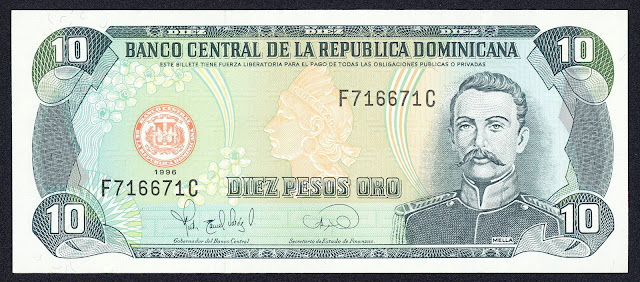Currency of the Dominican Republic 10 Pesos Oro banknote 1996 Matías Ramón Mella
Central Bank of the Dominican Republic - Banco Central de la República Dominicana
Obverse: Portrait of Matías Ramón Mella (25 February 1816 – 4 June 1864), is regarded as a national hero in the Dominican Republicat left, Medallic portrait of Indian Head Liberty at center; Seal of the Central Bank of the Republic at right. Blossoms of the Mahogany Tree, La caoba (Swietenia mahagoni) at upper left. Deep brown, red-brown and red on multicolor underprint.
Signatures: Hector Valdez Albizu (Gobernador del Banco Central) and Roberto Martínez Villanueva (Secretario de Estado de Finanzas).
Reverse: Coat of arms of the Dominican Republic at upper center. Quarry mining scene. Blossoms of the Mahogany Tree, La caoba (Swietenia mahagoni), formerly (1957-2011) the national flower and now the national tree of the Dominican Republic.
Printer: F. C. Oberthur (François-Charles Oberthür) France.
Dominican Republic Banknotes - Dominican Republic Paper Money
1977-1998
1 Peso Oro 1977-1988 1 Peso Oro 1984-1988 5 Pesos Oro 10 Pesos Oro
Matías Ramón Mella
Matías Ramón Mella (25 February 1816 – 4 June 1864), is regarded as a national hero in the Dominican Republic. The Order of Merit of Duarte, Sanchez and Mella is partially named in his honor.
Mella was born to Antonio Mella Álvarez (1794-1837) and Francisca Javier Castillo Álvarez (1790-1864).
He contributed significantly during 1844 Dominican War of Independence against Haiti, and was involved in the storming of St. Giles Fort by Dominican forces.
He was a member of the First Republic's provisional governing board, convened 28 February 1844. Leader of the Dominican independence. In 1838, sixteen years after the entire island of La Hispaniola unified under the domination of Haiti, Mella participated with other Dominican patriots (most notably Juan Pablo Duarte and Francisco del Rosario Sánchez) in founding La Trinitaria, a secret society with the aim of overthrowing the regime of Haitian dictator Jean-Pierre Boyer.
Subsequently Mella came into contact with the Haitian opposition leader Charles Hérard, who in turn led the reform movement. Together they managed to topple Boyer in 1843, but immediately Hérard imprisoned Mella in Port-au-Prince (Haiti). However, in this very city a rebellion erupted against Hérard, who was only able to dominate with the help of Mella and the incarcerated veterans whom he freed. Mella and his followers marched up to Santo Domingo, captured the eastern part of the island,and formally declared its independence from Haiti and the proclamation of the Dominican Republic in February 1844.
It is said that one night of February 27, 1844, when he was reunited with other conspirators at Puerta de La Misericordia (Mercy Gate), Ramon Matias Mella fired a shot to end the hesitation that threatened to bring failure. He fired his blunderbuss and the Patriots marched toward the stronghold of San Gennaro (today Conde Gate), where another patrician, Francisco del Rosario Sánchez, proclaimed to the world the birth of the Dominican Republic.
At the time of the Capotillo Outcry (Grito de Capotillo) (16 August 1863), already very ill, Mella served as vice president of the Republic of the government of the Restoration. He held this office until his death on June 4, 1864. He is entombed in a beautiful mausoleum, Altar de la Patria, at the Count's Gate (Puerta del Conde) alongside Duarte and Sánchez.

